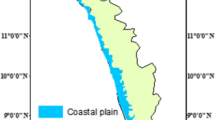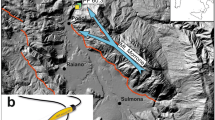Abstract
This study analyzed groundwater level changes in a monitoring well located in Korea’s Yangsan fault zone, induced by local (Gyeongju and Pohang) earthquakes in Korea and offshore earthquakes around the world. Among offshore earthquakes, the MW 7.3 Honshu earthquake changed raw groundwater level of a maximum of 10.3 cm. The groundwater level data were analyzed by using the Hilbert-Huang transform (HHT), modified moving average (MMA), and simple subtraction (SS) methods. In the first stage, earthquake-induced groundwater level changes were identified using the MMA and SS methods because the SS and MMA methods may excellently be used for identifying earthquake-induced groundwater level anomalies as a convenient way to identify abnormal fluctuations. Then, the HHT technique was applied to the 2016–2017 groundwater level data for comparison with the MMA and SS methods. The HHT method has been proven to be the most accurate method for detecting the effects of earthquakes on groundwater levels. The differences of water levels analyzed by the HHT method and the other two methods resulted in between 0.4 and 1.9 cm, showing closer levels between the HHT and SS methods.
Similar content being viewed by others
References
Barnes, A.E., 1992, The calculation of instantaneous frequency and instantaneous bandwidth. Geophysics, 57, 1520–1524.
Bedrosian, E., 1963, A product theorem for Hilbert transform. Proceedings of the IEEE, 51, 868–869.
Bower, D.R. and Heaton K.C., 1978, Response of an aquifer near Ottawa to tidal forcing and the Alaskan eartrhquake of 1964. Canadian Journal of Earth Sciences, 15, 331–340.
Bredehoeft, J.D., 1967, Response of well-aquifer systems to Earth tides. Journal of Geophysical Research: Solid Earth, 72, 3075–3087.
Brodsky, E.E., Roeloffs, E., Woodcock, D., Gall, I., and Manga, M., 2003, A mechanism for sustained groundwater pressure changes induced by distant earthquakes. Journal of Geophysical Research: Solid Earth, 108, B8. https://doi.org/10.1029/2002JB002321
Chang, K.-H., Suzukib, K., Park, S.-O., Ishida, K., and Uno, K., 2003, Recent advances in the Cretaceous stratigraphy of Korea. Journal of Asian Earth Sciences, 21, 937–948.
Chang, K.-H., Woo, B.G., Lee, J.-H., Park, S.-O., and Yao, A., 1990, Cretaceous and early Cenozoic stratigraphy and history of eastern Kyongsang basin, S Korea. Journal of the Geological Society of Korea, 26, 471–487.
Charmoille, A., Fabbri, O., Mudry, J., Guglielmi, Y., and Bertrand, C., 2005, Post-seismic permeability changes in a shallow fractured aquifer following a ML 5.1 earthquake (Fourbanne karst aquifer, Jura outermost thrust unit, eastern France). Geophysical Research Letters, 32, L18406. https://doi.org/10.1029/2005GL023859
Che, Y. and Yu, J., 1992, The statistical characteristics of groundwater level anomaly before some moderate-strong earthquakes in the Eastern China continent. Seismology and Geology, 14, 1, 23–29. (in Chinese with English abstract)
Chen, C.-H., Wang, C.-H., Wen, S., Yeh, T.-K., Lin, C.-H., Liu, J.-Y., Yen, H.-Y., Lin, C., Rau, R.-J., and Lin, T.W., 2013, Anomalous frequency characteristics of groundwater level before major earthquakes in Taiwan. Hydrology and Earth System Sciences, 17, 1693–1703.
Chen, C-H., Wang, C-H., Liu, J-Y., Liu, C., Liang, W-T., Yen, H-Y., Yeh, Y-H., Chia, Y-P., and Wang, Y., 2010, Identification of earthquake signals from groundwater level records using the HHT method. Geophysical Journal International, 180, 1231–1241.
Cheon, Y., Ha, S., Lee, S., Cho, H., and Son, M., 2017, Deformation features and history of the Yangsan Fault Zone in the Eonyang–Gyeongju area, SE Korea. Journal of the Geological Society of Korea, 53, 95–114.
Cheong, J.-Y., Hamm, S.-Y., Kim., S.-H., Lee., S.-H., Woo., N.-C., and Kim., G.-B., 2013, Analyzing groundwater change on a volcanic island caused by the impact of the M9 Sumatra earthquake. Geosciences Journal, 17, 183–195.
Chia, Y.P., Wang, Y.S., Wu, H.P., Chiu, J.J., and Liu, C.W., 2001, Changes of groundwater level due to the 1999 Chi-Chi earthquake in the Choshui River fan in Taiwan. Bulletin of the Seismological Society of America, 91, 1062–1068.
Choi, H.I., Oh, J.H., Shin, S.C., and Yang, M.Y., 1980, Geology and geochemistry of the Gyeongsang Strata in Ulsan Area. Korea Institute of Energy and Resources Bulletin, 20, 33 p.
Elkhoury, J.E., Brodsky, E.E., and Agnew, D.C., 2006, Seismic waves increase permeability. Nature, 441, 1135–1138.
Hahn, S., 1996, Hilbert Transform in Signal Processing. Artech House, London, 305 p.
He, A., Fan, X., Zhao, G., Liu, Y., Singh, R. P., and Hu, Y., 2017, Co-seismic response of water level in the Jingle well (China) associated with the Gorkha Nepal (MW 7.8) earthquake. Tectonophysics, 714, 82–89.
He, A., Singh, R.P., Sun, Z., Ye, Q., and Zhao, G., 2016, Comparison of regression methods to compute atmospheric pressure and earth tidal coefficients in water level associated with Wenchuan earthquake of 12 May 2008. Pure and Applied Geophysics, 173, 2277–2294.
Huang, N.E., Shen, Z., Long, S.R., Wu, M.C., Shih, H.H., Zheng, Q., Yen, N.C., Tung, C.C., and Liu, H.H., 1998, The empirical mode decomposition and the Hilbert spectrum for nonlinear and nonstationary time series analysis. Proceedings of the Royal Society A: Mathematical, Physical and Engineering Sciences, 454, 903–995.
Hwang, B.-H., Lee, J.-D., and Yang, K., 2004, Petrological study of the granitic rocks around the Yangsan fault: lateral displacement of the Yangsan fault. Journal of the Geological Society of Korea, 40, 161–178.
Hwang, B.-H., Lee, J.-D., Yang, K., and McWilliams, M., 2007a, Cenozoic strike-slip displacement along the Yangsan fault, southeast Korean Peninsula. International Geology Review, 49, 768–775.
Hwang, B.-H., McWilliams, M., Son, M., and Yang, K., 2007b, Tectonic implication of A-type granites across the Yangsan fault, Gigye and Gyeongju areas, southeast Korean Peninsula. International Geology Review, 49, 1094–1102.
Jeong, R.Y., 2018, Seismic hazard assessments in the Yangsan City, Gyeongsangnam-do Province, using geographic information system. Master Dissertation, Pusan National University, Busan, 45 p.
Jolivet, L., Huchon, P., Brun, J.P., Pichon, X.L., and Chamot-Rooke, N., and Thomas, J.C., 1991, Arc deformation and marginal basin opening: Japan Sea as a case study. Journal of Geophysical Research: Solid Earth, 96, 4367–4384.
Jonsson, S., Segall, P., Pedersen, R., and Bjornsson, G., 2003 Post-earthquake ground movement correlated to pore-pressure transients. Nature, 424, 179–183.
Kim, Y., Rhie, J., Kang, T.-S., Kim, K.-H., Kim, M., and Lee, S.-J., 2016, The 12 September 2016 Gyeongju earthquakes: 1. Observation and remaining questions. Geosciences Journal, 20, 747–752.
King, C.-Y., Azuma, S., Igarash, G., Ohno, M., Saito, H., and Wakita, H., 1999, Earthquake-related water-level changes at 16 closely clustered wells in Tono, central Japan. Journal of Geophysical Research: Solid Earth, 104, 13073–13082.
Korea Institute of Geoscience and Mineral Resources, Available at: https://doi.org/mgeo.kigam.re.kr/
Korea Meteorological Administration, Available at: https://doi.org/kma.go.kr/
Korea Meteorological Administration, Available at: https://doi.org/necis,kma.go.kr/
Lay, T. and Wallace, T.C., 1995, Modern Global Seismology, vol. 58. Academic Press, San Diego, 521 p.
Lee, H.A., 2013, Investigation of groundwater response to earthquakes using the national groundwater monitoring data of Korea. Ph.D. Thesis, Yonsei University, Seoul, 175 p.
Lee, M.S. and Kang, P.C., 1964, Explanatory text of the geological map of Yangsan sheet (scale 1:50,000). Geological Survey of Korea, Seoul, 43 p.
Lee, S.-H., Cheong, J.-Y., Park, Y.-S., Ha, K., Kim, Y.C., Kim, S.-W., and Hamm S.-Y., 2017, Groundwater level changes on Jeju Island associated with the Kumamoto and Gyeongju earthquakes. Geomatics, Natural Hazards and Risk, 8, 1783–1791.
Lee, S.-H., Ha, K., Shin, J.S., Ko, K.-S., and Hamm, S.-Y., 2013, Successive groundwater level changes on Jeju Island due to the MW 9.0 off the Pacific coast of Tohoku earthquake. Bulletin of the Seismological Society of America, 103, 1614–1621.
Mang, M. and Wang, C.Y., 2007, Pressurized oceans and the eruption of liquid water on Europa and Enceladus. Geophysical Research Letters, 34, 7. https://doi.org/10.1029/2007GL029297
Matsumoto, N., 1992, Regression-analysis for anomalous changes of groundwater level due to earthquakes. Geophysical Research Letters, 19, 1193–1196.
Matsumoto, N., Kitagawa, G., and Roeloffs, E.A., 2003, Hydrological response to earthquake in the Haibara well, central Japan–I. Water level changes revealed using state space decomposition of atmospheric pressure, rainfall and tidal responses. Geophysical Journal International, 155, 885–898.
Muir-Wood, R. and King, G.C.P., 1993, Hydrological signature of earthquake strain. Journal of Geophysical Research: Solid Earth, 98, 22035–22068.
Narasimhan, T.N., Kanehiro, B.Y., and Witherspoon, P.A., 1984, Interpretation of Earth tide response of three deep, confined aquifer. Journal of Geophysical Research: Solid Earth, 89, 1913–1924.
Orihara, Y., Kamogawa, M., and Nagao, T., 2014, Preseismic changes of the level and temperature of confined groundwater related to the 2011 Tohoku Earthquake. Scientific Reports, 4, 6907. https://doi.org/10.1038/srep06907
Quilty, E. and Roeloffs, E.A., 1997, Water level changes in response to the December 20, 1994, M4.7 earthquake near Parkfield, California. Bulletin of the Seismological Society of America, 87, 310–317.
Roeloffs, E.A., 1988, Hydrologic precursors to earthquakes: a review. Pure and Applied Geophysics, 126, 177–206.
Roeloffs, E.A., 1998, Persistent water level changes in a well near Parkfield, California, due to local and distant earthquake. Journal of Geophysical Research: Solid Earth, 103, 869–889.
Roeloffs, E.A., Sneed, M., and Galloway, D.L., 2003, Water-level changes induced by local and distant earthquakes at Long Valley caldera, California. Journal of Volcanology and Geothermal Research, 127, 269–303.
Rojstaczer, S., Wolf, S., and Michel R., 1995, Permeability and enhancement in the shallow crust as a cause of earthquake-induced hydrological changes. Nature, 373, 237–239.
Sil, S. and Freymuller, J.T., 2006, Well water level changes in Fairbanks, Alaska, due to the great Sumatra-Andaman earthquake. Earth Planets Space, 58, 181–184.
Singh, V.S., 2008, Impact of the earthquake and Tsunami of December 26, 2004, on the groundwater regime at Neill Island (south Andaman). Journal of Environmental Management, 89, 58–62.
Um, S.H., Choi, H.I., Son, J.D., Oh, J.H., Shin, S.C., and Yun, H.S., 1983, Geology and geochemical study of Gyeongsang super group in the Gyeongsang Basin. Korea Institute of Geology, Mining, and Minerals (KIGAM), Research Report, Seoul, 36, 118 p.
Van der Kamp, G. and Gale, J.E., 1983, Theory of Earth tide and barometric effects in porous formations with compressible grains. Water Resources Research, 19, 538–544.
Wakita, H., 1975, Water wells as possible indicators of tectonic strain. Science, 189, 553–555.
Wang, C.-Y., Chia, Y., Wang, P.L., and Dreger, D., 2009, Role of S waves and Love waves in coseismic permeability enhancement. Geophysical Research Letters, 36, L09404. https://doi.org/10.1029/2009GL037330
Wang, C.Y., 2007, Liquefaction beyond the near field. Seismological Research Letters, 78, 512–517.
Wang, C.Y. and Chia, Y., 2008, Mechanism of water level changes during earthquakes: near field versus intermediate field. Geophysical Research Letters, 35, L12402. https://doi.org/10.1029/2008GL034227
Zheng, X. and Feng, D., 1989, A fuzzy method for evaluating the earthquake monitoring ability of the precursors with seismic activity. North China Earthquake Sciences, 10, 20–24. (in Chinese with English abstract)
Author information
Authors and Affiliations
Corresponding author
Rights and permissions
About this article
Cite this article
Yun, SM., Hamm, SY., Cheong, JY. et al. Analyzing groundwater level anomalies in a fault zone in Korea caused by local and offshore earthquakes. Geosci J 23, 137–148 (2019). https://doi.org/10.1007/s12303-018-0062-8
Received:
Accepted:
Published:
Issue Date:
DOI: https://doi.org/10.1007/s12303-018-0062-8




